Family : Cycadaceae

Text © Prof. Pietro Pavone

English translation by Mario Beltramini
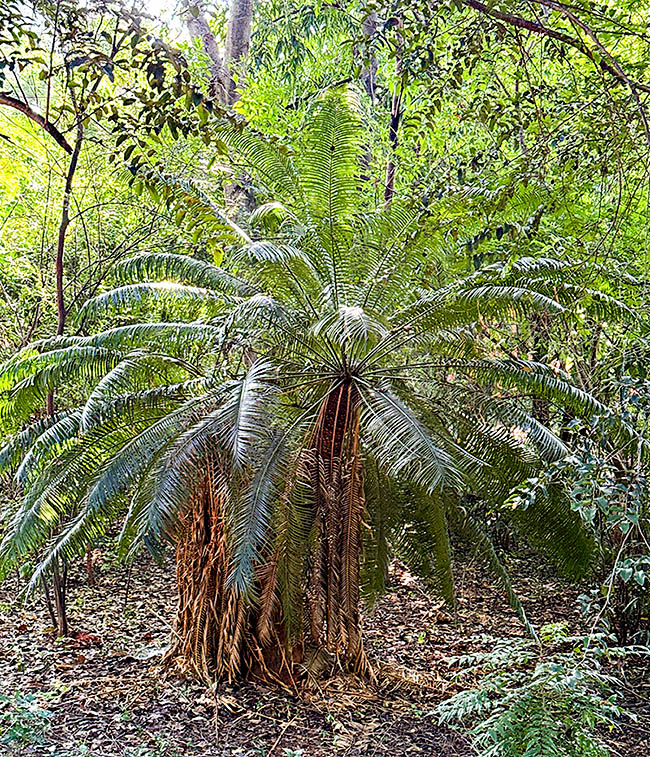
Cycas circinalis is an arborescent plant, up to 10 m tall, with an elegant crown of pinnate leaves © Vijay Anand Ismavel
Cycas circinalis L. is a gymnosperm of the family of the Cycadaceae, order Cycadales, validly described by Carl Linnaeus (1707-1778) in 1753 in Species Plantarum (Sp. Pl. 2:1188).
Among the Gymnosperms, the order Cycadales is the most primitive of all seed plants that appeared about 350-280 million years ago, and includes the families Cycadaceae, Stangeriaceae and Zamiaceae with more than 330 species.
The family Cycadaceae is the oldest in the order, whose fossils date back to the last period of the Primary Era (Permian) with species taxonomically different and numerous in the following Mesozoic Era (Jurassic).
They appeared before the dinosaurs, existed together with them, colonized the whole planet, but unlike them never died out completely.
As a matter of fact, the present species, reduced compared to the past, are real “living fossils” with a distribution in the tropical and subtropical regions of the world.
Presently, the family counts only one genus: Cycas with 117 species.
This genus is characterized by species having a pachychaoulous stem, that is stocky and shaped like a column, not ratified, with a crown of big pinnate leaves, featherty or rigid depending on the species.
They look like palms (but they are evolutionarily distant), with big leaves (macrophyllous), initially circinate, coriaceous, ever-green, pinnate-compound (rarely, bipinnate-compound) that are inserted alternately to form a crown at the apex of the stem. In all their parts, these plants have channels with mucilage.
Also sexual reproduction denotes common origin and primitiveness.

Endemic species confined in south-western part of Indian peninsula of Western Ghats and nearby regions. Since 1986 Unesco has formed in this zone the Nilgiri Biosphera Reserve due to the high concentration of endemic species considering it as one of the hotspots of biodiversity where their conservation is a priority © Urmimala Singh
All species produce microsporophylls and macrosporophylls and these reproductive structures stand always on separate individuals, being these plants typically dioecious.
The vegetative apex is constantly growing and periodically produces normal leaves and sporophylls.
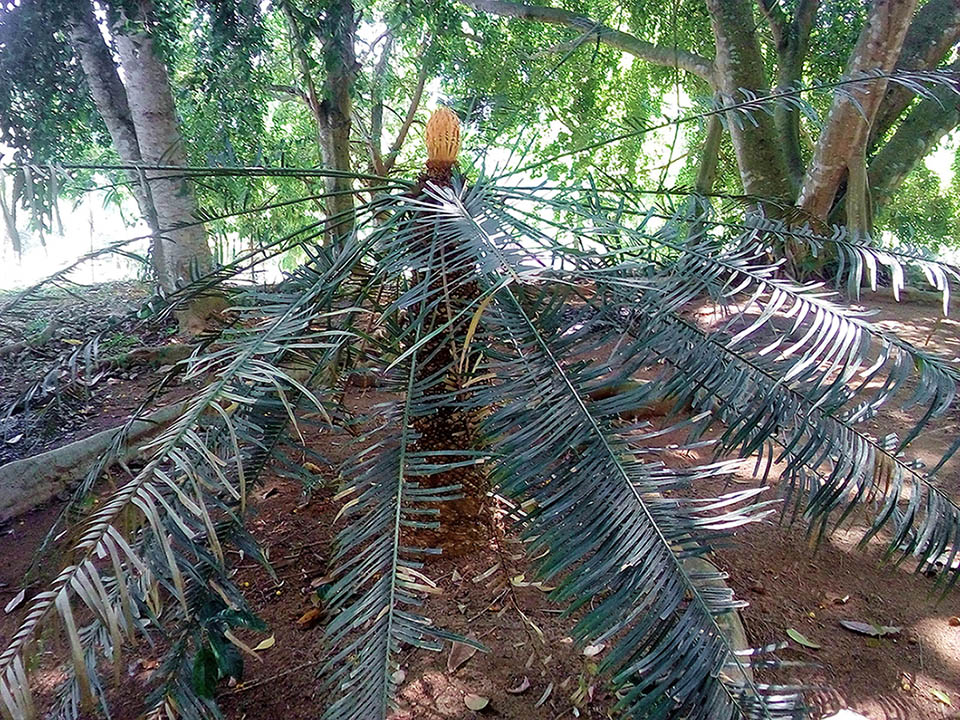
Thanks to the combined analysis of morphological and molecular data, Cycas circinalis has been reported as spontaneous also in Sri Lanka © QuestaGame
In addition to the normal root system, these plants have secondary superficial roots, with ramified coralliform swellings (coralloid roots), often with nitrogen fixing cyanobacteria like Anabaena and Nostoc with whom they live in symbiosis.
In this way they are able to grow also in soils poor in nitrogen. Their seeds are bare because not inside an ovary that is present only in the Angiosperms.
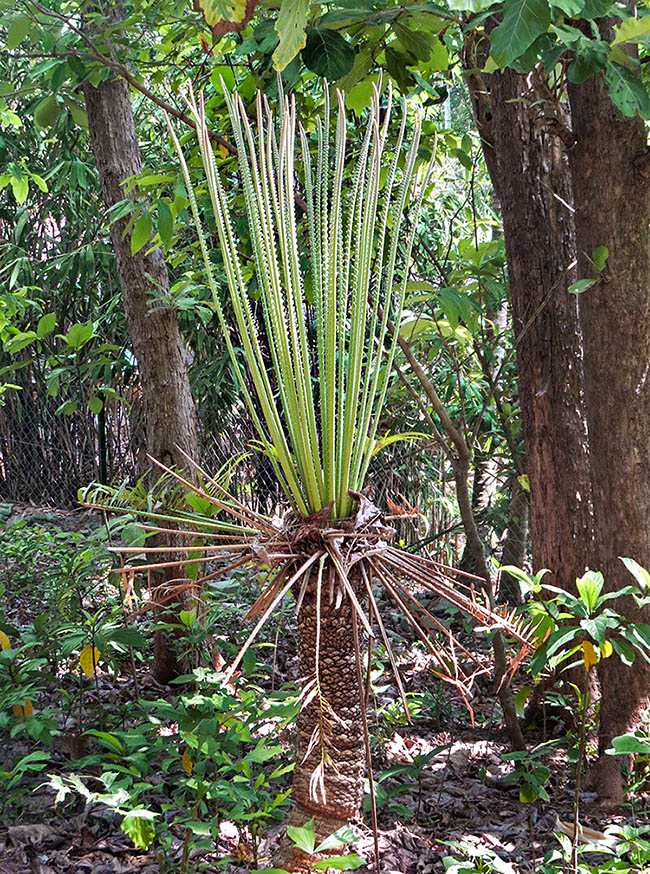
New forming leaves after a wild pruning for the trade of the ornamental and edible laminae © Monal Peroth
Cycas circinalis is an endemic species confined to the south-west part of the Indian peninsula: Western Ghats or Sahiadry (benevolent mountains).
In particular, it is found in the states of Kerala, Tamil Nadu and, sporadically, in the south of the state of Maharashtra.
Recently it has been reported, in a spontaneous state, also in Sri Lanka (Flora 290, 2022, 152044) thanks to the combined analysis of morphological and molecular data.
It lives in different habitats, like thick and seasonally dry deciduous forests, rocky outcrops, dry stream beds, from the hilly areas (1200 m of altitude) up to the sea level.
In Kerala it is also found in the low altitude tea plantations, in the bamboo groves and in the areas subject to fires.
In some of these habitats the trees lose the leaves in the dry season and also Cycas circinalis can be optionally deciduous especially in very dry periods.
The plants of Cycas circinalis living in the mid-altitude deciduous dry forests produce one series of leaves only once in a year, whilst those present in the low-altitude humid forests produce several ones of them during the year.
The name of the genus is made to derive, as per a Theophrastus’ quotation for an unidentified palm, from the Greek κύκας (cýkas) in turn derived, due to a wrong transcription, from κόικας (cóikas) plural accusative of κόιξ (coix) due to its resemblance to the palm trees.
The name of the species originates from the Latin word “circinus” that means rolled up leaves opening during the development.
Vulgarly, it is known as “Queen Sago palm”, “jangli-madan-mast-ka-phul” in Hindi language (national language of the Indian Union).
Cycas circinalis is a plant with arborescent trunk, up to 7 (10) m tall and a diameter of 12-27 cm, with thick and corky bark covered by triangular cataphylls, silky or without tomentum and with persistent foliar bases.
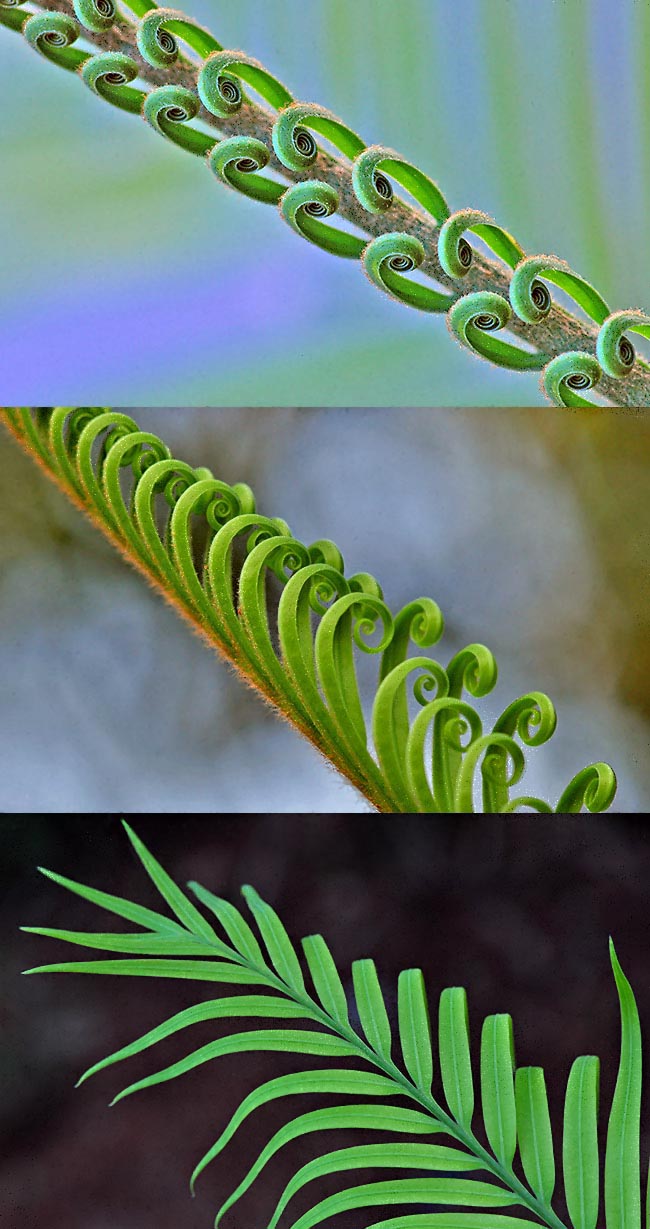
Interesting sequence of foliar growth. To note the leaflets wrapped pastorally, like in the world of the ferns. A sign of archaism in this living fossils that recall us the fascinating evolutionary history of the plants © Sam Thekkethil
The trunk ends in a crown of bright green pinnate leaves, semi glossy, 150-270 cm long, supported by a petiole, 35-70 cm long, glabrous and spinescent.
The leaflets, 54-110 in number, are opposite, inserted at a flat angle on the central rib (rachis).
They are 220-360 mm long, 9-13 mm wide, narrowed to 2,5-4 mm at the base, with flat margins, not wavy and with delicately sharp apex, reflexed, not spinescent.
These leaf characteristics distinguish this species from all the others present in India.
The central rib is narrow and raised on the upper pagina.
There are also scaly leaves (cataphylls) of triangular shape, soft, at times with a thin tomentum, 5 cm long.
In the inner part the stem has a pith formed by a parenchymatous tissue rich in carbohydrates.
Cycas circinalis is a dioecious species, like the rest of all Cycadales, which means that male and female individuals do exist.
These are sporophytes forming microsporangia (the male plants) and macrosporangia (the female plants).
The male individuals form, at the extremity of the stem, a pinecone (strobile) pedunculated, compact and woody, ovoid to conical in shape, pale brown to brown.
It’s 24-48 cm long and has a diameter of 12-8 cm, formed by microsporophylls (scales of the cone) not dorso-ventrally thickened and spirally arranged round the central axis.
They are 45-60 mm long, 21-24 mm wide, with an about 5 mm apex merging with the apical spine progressively raised and 20-39 mm long.
The microsporangia, also called pollen sacs, are found only on the side opposite to the one facing the axis of the cone (abaxial face) and appear in groups of 3 or 4.
Each of these groups represent a “sorus”.
Each sporophyll contains about 1000 microsporangia and many grains of pollen each.
The pollen grains are pale yellow, pulverulent, spheroidal in shape (24,9 μm), unicellular and uninucleated, surrounded by a thick outer wall, resistant and waterproof (exine) and a thin inner one (intine).
While ripening the cones get longer and dilate the sporophylls so as to allow the exit of the pollen.
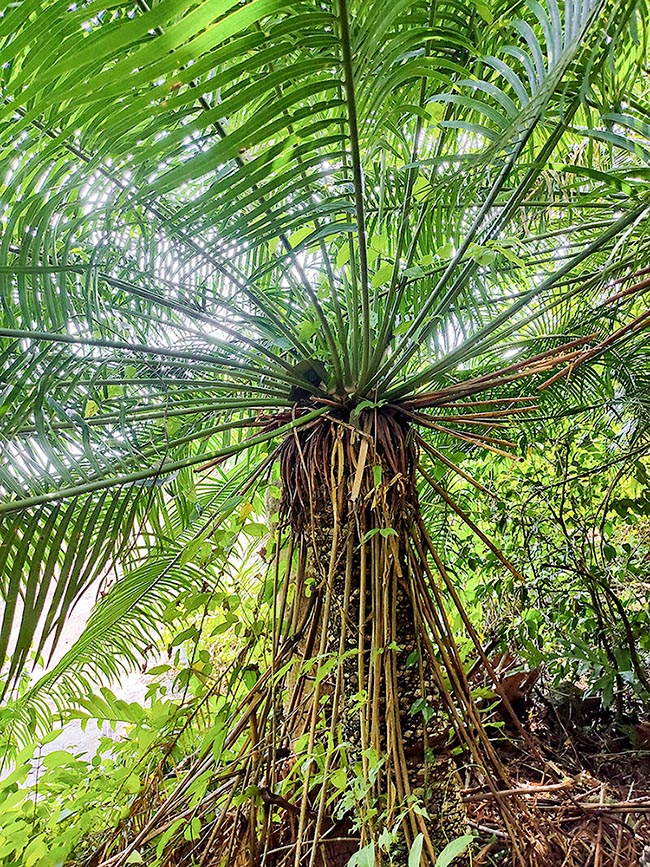
Cycas circinalis looks like a palm, but evolutionarily very distant from these plants © Adithyan A Saj
The female plants, like Cycas revoluta and the other species of this genus, do not form cones but structures made by macrosporophylls with the upper part sterile, similar to feathers, that form at the apex of the trunk.
They are tomentose, orange in colour and with large ovules at the edges, glabrous and in number of 4-14.
The lamina is lanceolate, 27-40 mm long, 23-34 mm broad, regularly toothed, with 10-28 sharp lateral 1-4 mm long spines.
The ripening of the pollen occurs from April to June at the same time of the receptivity of the ovules.
During the pollen maturation has been noted the production of endogenous heat of about 1,60 °C compared to the environment temperature, along with a slight fetid smell whose intensity decreases after about five days.
While the female cones do not produce any odour detectable during the process of ripening.
For a long time it was believed that the pollination was made exclusively by the wind, but recent studies (Chemistry & Material Sciences Research Journal Vol. 2(1), pp. 6-14, 2020) have highlighted that Cycas circinalis is also pollinated by a beetle (a sort of weevil or bean weevil) that finds protection in the pollen cone and in the macrosporophylls.
This explains the success of these plants in the undergrowth of the tropical forests, where there is little wind.
The fecundation, that is the union of the male gamete with the female one, occurs several months after the pollination, and happens by means of motile ciliated spermatozoids that are freed by the germination of the pollen into the liquid filling up the “archegonial chamber”, placed at the apex of the ovule, where stand the female reproductive organs (archegonia) each one with an oosphere (female gamete) awaiting to get fecundated by a spermatozoid.
After the pollen is released, the male cones gradually bend to one side in order to leave free room for the formation of the new leaves and remaining in this position for about one year.
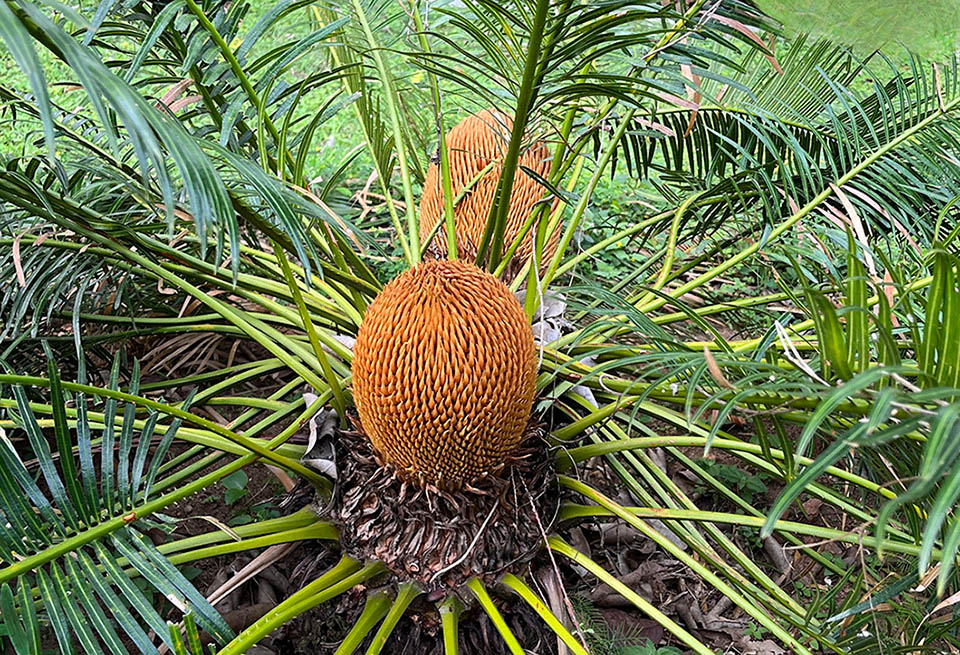
Cycas circinalis is a dioecious species, that is characterized by male and female individuals. The first form, at the tip of the stem, a pollen cone © Madhushri Mudke
The fecundation is followed by he formation of the zygote that develops in one single big embryo.
Then the ovule becomes a seed whose shape is subglobose or slightly elongated (30-39 mm x 20-24 mm) with an integument formed by four layers.
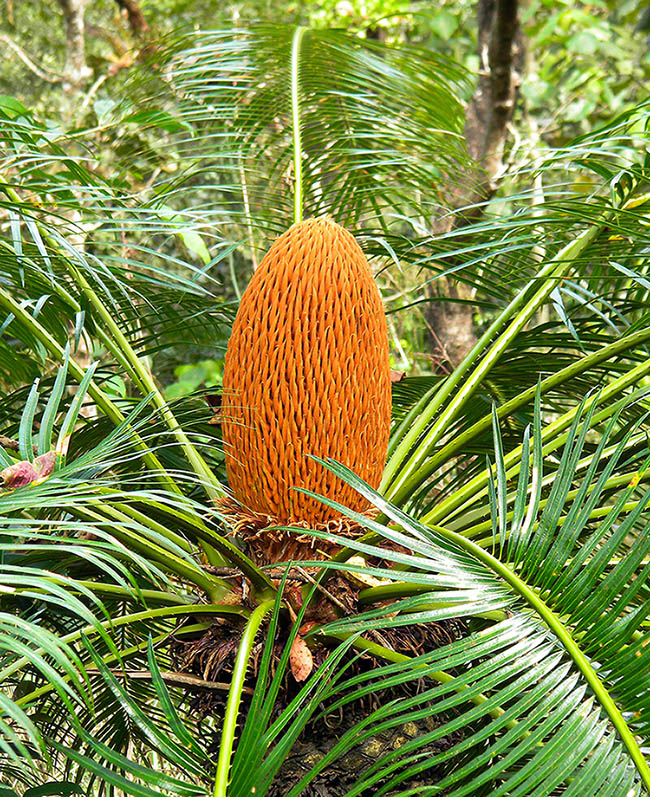
This is a giant stalked strobilus, compact and woody, formed by spirally arranged scales. It recalls the cones of the conifers, other plants of ancient lineage who belong like the Cycas to the group of Gymnosperms © Ansil B. R.
The outer layer (sarcotesta) is fleshy and if of pale yellow, yellow-pinkish or brown colour when ripe, the intermediate layer (sclerotesta) is hard, lignified and smooth and forms a real shell containing a subsequent coating spongy layer and, finally, an inner layer (endotesta) that is a thin membranous sheath that encloses the embryo that remains stuck to the tissue of the female gametophyte for a period of up to two years and the provides nutrition to the future seedling.
The outer layer of the seed at the end gets wrinkled and in this phase the seeds fall down, usually in the late winter season, and in the presence of water can be dragged to other places during the rain season, thanks to the spongy layer that allows them to float, favouring their dispersion.
The dispersion of Cycas circinalis eeds is done also by the Indian flying fox (Pteropus giganteus Brünnich, 1782) and by the Indian deer Sambar (Rusa unicolor Kerr, 1792) who feed on the fleshy outer layer, with a pungent taste.
It has been noted that the removal of this layer stimulates the seeds germination.
Karyological studies have evidenced that both male and female individuals have a chromosomal set of 2n=22.
In addition to sexual reproduction Cycas circinalis may reproduce asexually, but it has been observed only in the male plants.
From the trunk generate sprouts in the form of bulbils that grow on the same plant to produce new additional stems or fall down to generate new plants.
The new buds, if they remain stuck to the plant, grow and, when ripe, form each one a male cone thus contributing to increase the number of cones and consequently the quantity of pollen per individual.
It is thought that deforestation has destroyed more than 50% of the native habitats of Cycas circinalis.
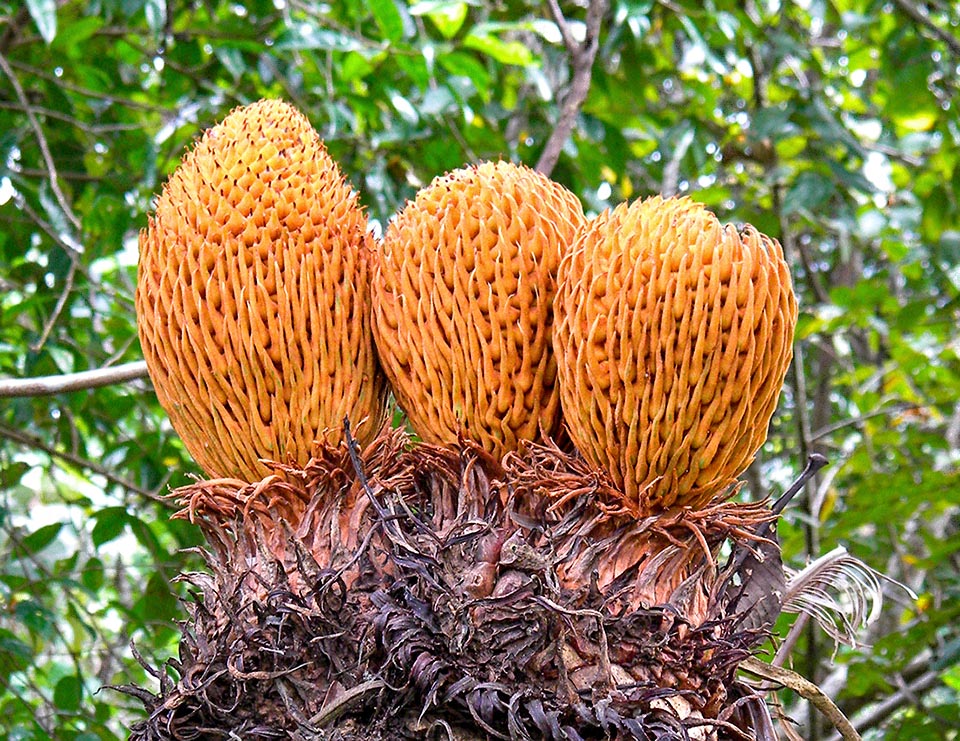
Rarely take form more cones at the apex of the same stem, but this is good because it increases the number of pollen grains present under the scales © Ansil B. R.
To this we add the marrox collection, of the male cones, of the leaves and of the seeds, for local use as well as for the flower market, with as consequence aa additional impact on this species.
The seeds, deprived of the integuments are utilized in the native range for food purposes but due to the presence of very toxic compounds, like the glycosid cycasin and an amino acid that causes chronic nervous disorders.
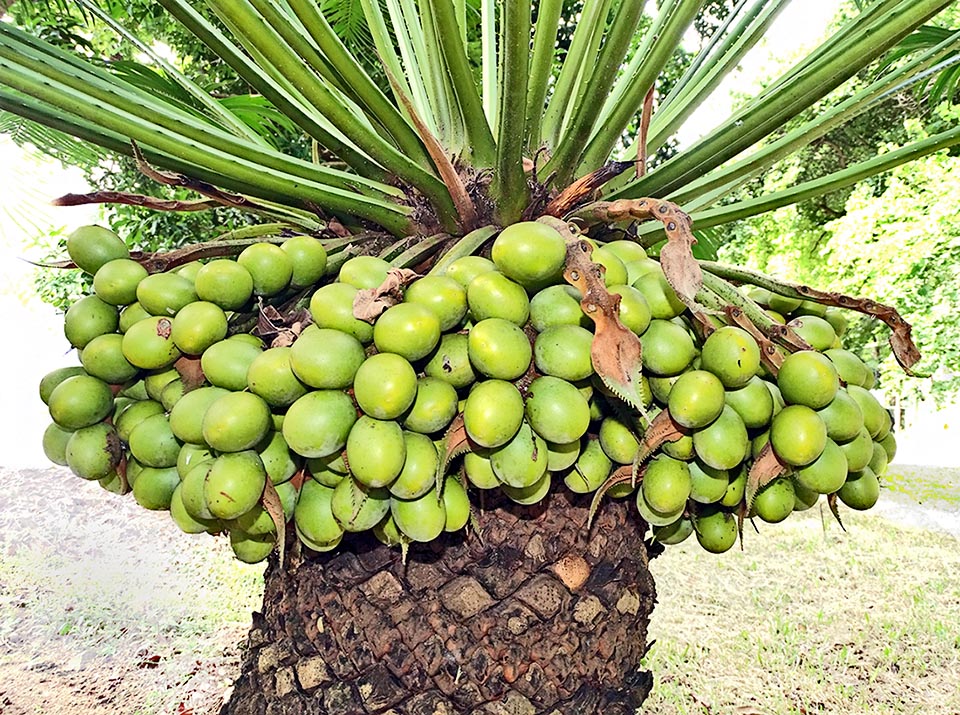
The female plants don’t form cones but foliar structures similar to feathers set at the apex of stem. At the edge they have big ovules waiting for pollen to transform in seeds © renjus box
They are cut into thin slices and placed in water with several changes (five at least), then dried.
After drying they are reduced in flour for preparing quite nutritious focaccias, like tortillas, tamales and porridge (a sort of locally appreciated soup).
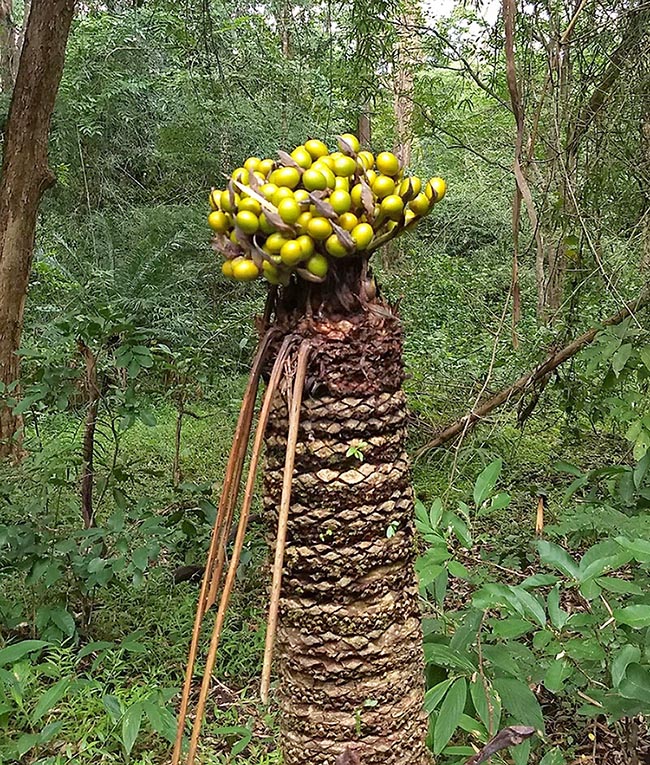
In Kerala the species is seriously endangered as, besides the leaves, also the seeds are often collected for food purposes and the stem marrow is very often transformed into flour. The male cones, with not yet freed pollen, are also often cut and placed in rice fields to repel the parasites that attack the ripening caryopses © renjus box
It has been proven, however, that the consumption of this flour, if not well purified, can cause serious neurological problems.
ïn Kerala the seeds are collected from June to August.
Also the ùarrox of the trunk, after several washes, is utilized by the local population for preparing a fecula of sago or sagu.
Similarly, the local population utilizes the tender leaves cut in small pieces and left overnight, in water before cooking and eating them.
The leaves for these purposes are required between January and February and from October to November.
Conversely, the mature leaves serve to decorate the temples during the festivals and for floral decorations.
The male cones, with the pollen not yet freed, are highly sought after by the local rice growers to be placed in the fields as they are able to repel the parasites that attack the ripening caryopses.
Cycas circinalis hosts the butterfly Plains cupid or Cycad blue (Luthrodes pandava Horsfield, 1829, family Lycaenidae).
The adult lays the eggs on the young leaves and after a few days get free the larvae that feed on the young shoots.
When they have finished feeding, the larvae gather at the base of the leaves, pupate and within 7-9 days, they transform into adult butterflies.
On the plant have been observed also ants and stingless bees (Trigona spp., tribe Meliponini).
These latter produce the propolis, an antibacterial and antiviral food, that is collected by the bees from the resinous secretions of the leaves as soon as they emerge (extrafloral nectars) and then mixed with beehive wax.
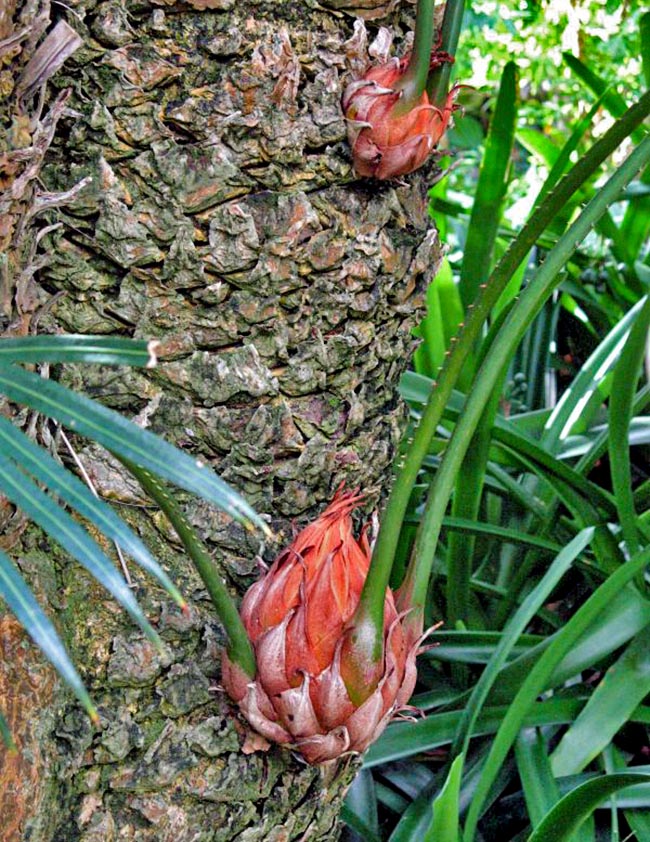
Besides sexual reproduction Cycas circinalis may reproduce asexually. From the trunk can sometimes form sprouts with the shape of bulbils that can grow on the same plant, or fall down to generate new plants © Linda De Volder
Thanks to this food their colonies become resistant to bacterial and viral infections which, otherwise, might be destroyed. The leaves and the marrow of Cycas circinalis also have medicinal properties.
In fact, they are used for controlling high blood pressure, headache, congestion, rheumatisms and pains in general. Unfortunately, large and ancient specimens are constantly shot down for the extraction of the marrow.
The scales of the mle cone are commonly sold in India in the bazaars to be utilized as analgesic because the pollen has a narcotic action.
The mucilaginous apical buds, if pressed in water with rice or with clay, are utilized to treat ulcerated wounds and boils.
The juice of the most tender leaves is useful in the treatment of flatulence. The purified leaf decoction is able to soothe cough.
The high demand of plants of Cycas circinalis, united with its slow growth, has imposed an effective protection stimulating the cultivation in the nurseries and a better protection of the wild populations.
In fact, Cycas circinalis is considered as an endangered species inserted in 2020 in the IUCN Red List as (Endangered, EN).
It is also present in the Appendix II of the CITES to prevent exports. A defense plan for this species is implemented by the non-governmental volunteer agency Keystone Foundation that since three decades is working to improve the quality of the life of both indigenous communities, who draw sustenance from the products collected in nature, and to protect the ecosystems with high biodiversity.
The Agency works in the areas of the Nilgiri Biosphere Reserve, in the state of Karnataka (southern Indi), created by UNESCO in 1986 which was the first Indian protected reserve of biosphere.
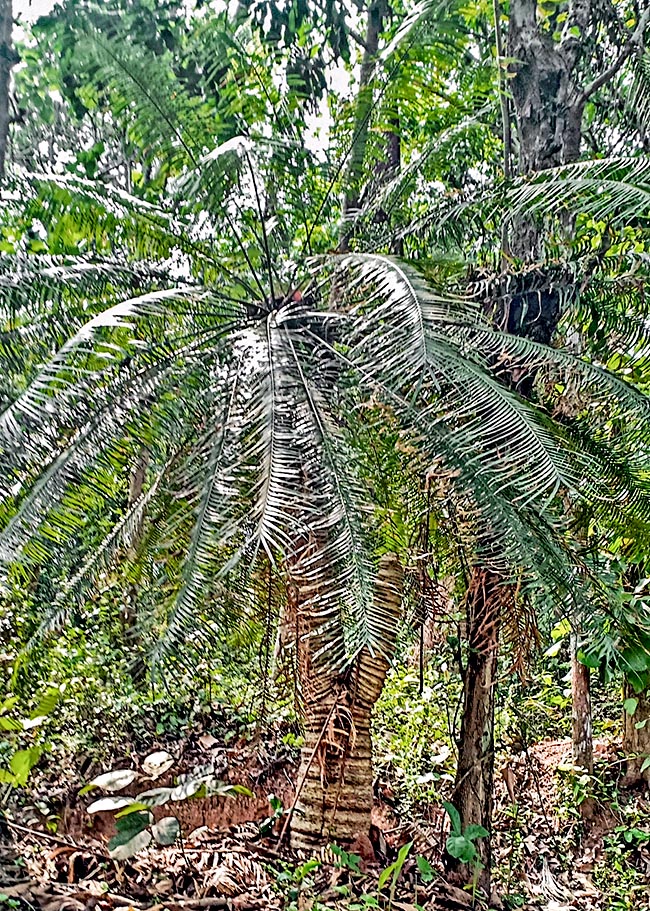
It may happen, as in this case, to find a ramified plant having two heads © Balakrishnan Peroth
The reserve is embedded between the Western Ghats and the Nilgiri Mountains (Blue Mountains) and covers an area of about 640 square kilometres with ecosystems standing among the oldest in the world.
From a biogeographical point of view the region of the Western Ghats due to its high concentration of endemic species living in habitats endangered by human activities stands in the “hotspots” of biodiversity whose conservation is a priority.
Cycas circinalis is a species amply cultivated in several parts of the world, especially in the tropics and warm subtropics, as ornamental garden plant and for the interiors, but also for its cut foliage in the floral compositions.
For a good cultivation, while tolerating various types of soils, prefers the loose sandy soils with organic material of vegetable origin, like leaves mulch.
It can stand the full sun and also the moderate shadow. It requires adequate moisture in the soil if well drained, occasionally may tolerate drought provided short-lasting.
Propagation is done by seed tah is to be placed into the humid sand at a depth of about half its size.
The fecundated seeds, kept humid and in a warm environment, may usually germinate in 8-12 weeks, much more (6-18 months) if waiting for fecundation.
The plant can be transplanted also when the specimens are rather big. The best moment for doing this is by the beginning of the new growth season. If the roots are damaged during the uprooting, they may be cut and even some leaves for reducing the transpiration.
The new roots will develop easily as the months go by. In intensive cultivations the plant can be attacked by fungi and by cochineal insects.
The first ones are to be treated with a fungicide in particular for controlling the dots on the leaves, the second ones with applications of insecticides, of horticultural oil and/or of insecticidal soap solutions.
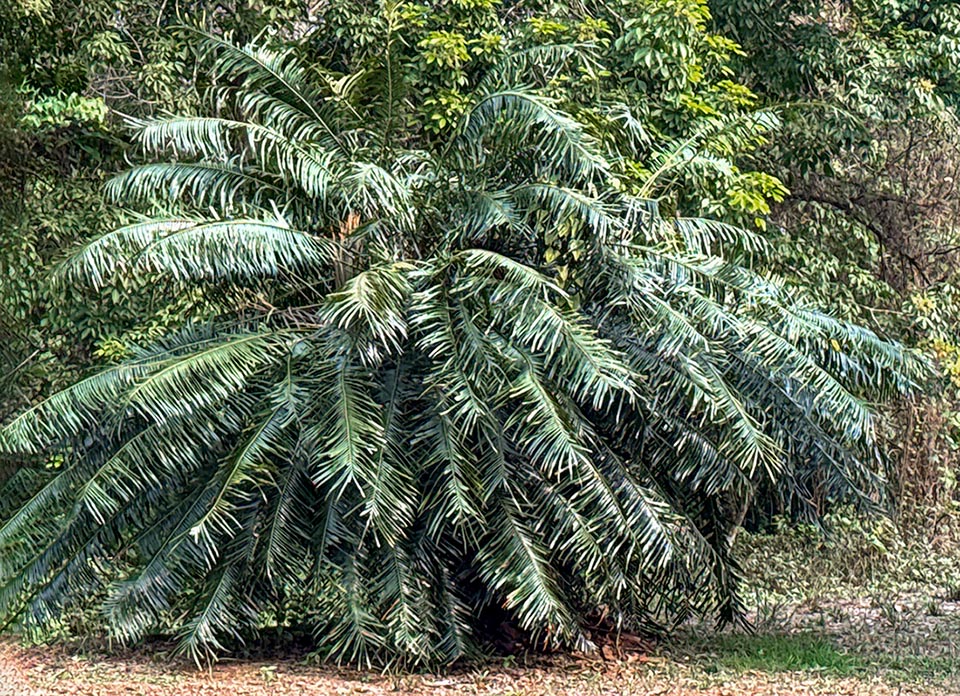
Cycas circinalis is amply grown especially in the tropical and warm subtropical climates, as garden ornamental plant or for interiors © Vijay Anand Ismavel
Synonyms: Cycas circinalis var. vera J.Schust. (1932); Palma polypodiifolia Mill. (1768); Cycas circinalis var. angustifolia Miq. (1840); Cycas circinalis var. glauca J.Verschaff. (1887); Cycas circinalis f. gothanii J.Schust. (1932); Cycas circinalis f. undulata (Desf. ex Gaudich.) J.Schust. (1932); Cycas rumphii f. undulata (Desf. ex Gaudich.) Kaneh. (1938); Cycas squamosa Lodd. ex Dyer (1881); Cycas squarrosa Lodd. ex G.Don (1830); Cycas undulata Desf. ex Gaudich. (1829); Cycas wallichii Miq. (1842)
→ To appreciate the biodiversity within the CYCADACEAE family please click here.
